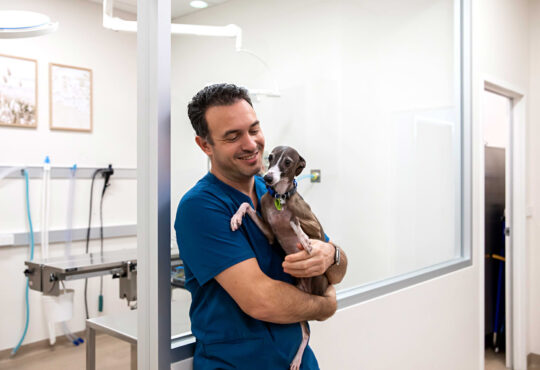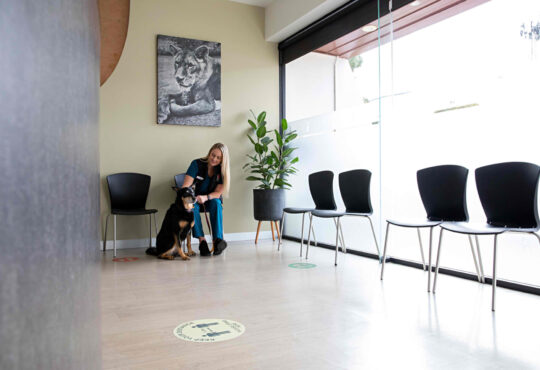A tibial plateau levelling osteotomy (TPLO) is a common procedure that involves realigning the angle of the tibia by cutting the bone and rotating the tibial plateau (or the flattened top to the tibia). In a normal stifle, the cranial cruciate ligament (CrCL) prevents the tibia from sliding too far forward or excessively rotating inward. This technique achieves joint stability by providing sufficient support and eliminating the need for the now-injured CrCL, improving your pet’s mobility and overall quality of life.
Benefits of TPLO surgery:
- Stabilisation of stifle joint
- Suitable for medium to large dogs
- Reduced risk of long-term complications (e.g arthritis)
- Improved long-term prognosis
- Better quality of life
All of our TPLO surgeries are performed by our principal veterinarian Dr Adam Stefani, with assistance from Dr James Martin, and supported by our team of veterinary nurses.
Prior to the surgical procedure commencing, the patient is provided with a “pre-medication”. This involves a combination of drugs to facilitate pain relief and assist the induction, maintenance, and recovery from the general anaesthetic. X-rays are taken at this stage to obtain precise measurements for tibial plateau readjustment.
Once induced and under a general anaesthetic, the veterinarian will administer a local anaesthetic via an epidural. This method of local anaesthetic administration provides a highly successful loss of sensation in the hindlimbs and facilitates a smooth general anaesthetic. Additionally, this provides immediate pain relief during the post-anaesthetic recovery period. Intravenous fluids are administered throughout the procedure.
After the surgical site is prepped and sterilised for surgery, an incision into the joint is made. The joint capsule is explored and the cruciate ligaments and menisci (the cartilage pads in the stifle) are inspected for signs of damage. Any debris or damage due to the initial injury is cleared out of the joint to facilitate healing and recovery.
After the joint capsule is closed, the veterinarian will make a circular cut through the tibia. The section of bone is then repositioned using measurements obtained from x-rays of the stifle taken pre-operatively. A bone plate and orthopaedic screws are used to secure the new position of the tibial plateau. The surgical site is then closed with sutures.
After x-rays are repeated to ensure correct placement of the plate and screws, the leg is bandaged.
The patient is then closely monitored by our surgical team during the recovery period.
Post-Operative Care
Exercise Restriction
Limited mobility and rest is required for a specific period of time, as specified by the veterinarian. Confinement to a small, quiet room and/or crate and using a leash while toileting is necessary to help prevent excessive movement.
We understand that keeping a dog quiet and still is often easier said than done. At-home enrichments, such as slow feeders or puzzle toys, can be a great way to entertain your dog.
Wound Management
The bandage will remain in place for 4-5 days. After this is removed, it’s important to prevent excessive licking of the surgical site to avoid a possible infection and/or removal of the sutures. An e-collar, cone or other alternatives will need to be used, especially when unsupervised (e.g. overnight or when you are not at home). Additionally, we can supply you with a bitterant solution to deter them from licking the site.
Patients are not able to swim or be bathed until the surgical site has healed and sutures removed.
Rehabilitation
A structured rehabilitation program for your dog after surgery is critical to their recovery. This guidance is tailored to the individual patient and their personal progress. At Mornington Vet Clinic we understand that there are numerous forms of rehabilitation therapy and are happy to adjust the rehabilitation program to ensure that it works for both you and your dog.
It is vital to the healing process that controlled walks and rehabilitation is introduced under the guidance of your veterinarian to ensure successful healing, joint function, and the regaining of mobility.
I’ve booked my pet in for a TPLO - what can I expect?
Pre-Operative Phone Call
The day prior to surgery, one of our nurses will call you to confirm your admission time and provide specific instructions regarding fasting and withholding water. During the phone call, we can address any last-minute questions or concerns you may have.
Admit appointment
During admission, the surgery nurse will ask you some questions about your pet and you will be asked to fill out and sign a consent form that allows us to admit them into our hospital and perform surgery. We will ask you for the best number to contact you on while your pet is with us – it’s important that we have a reliable contact number for you in case we have any questions or concerns, so we can update you once they are awake. Admission usually takes around 5 minutes.
Discharge appointment
Once your pet is in recovery, we will call you to provide an update and book a discharge appointment. These appointments are generally between 6 pm and 7 pm, depending on how your quickly your pet recovers from the anaesthetic and epidural. The vet will discuss aftercare requirements and medications to be given at home – a hard copy of this information will also be provided for you to take home.
Post-Operative Progress Checks
Progress checks are included throughout the recovery process to ensure proper healing and to discuss rehabilitation for optimal results post-ECR.
- Day 1 post-op: Phone call with a nurse to check on your dog’s recovery overnight
- Day 4-5 post-op: Appointment with a veterinarian to assess progress and remove the bandage
- 2 Weeks post-op: Appointment with a veterinarian to re-examine the stifle
- 6 Weeks post-op: Appointment with veterinarian plus x-rays to evaluate bone healing
- 12 Weeks post-op: Final appointment with veterinarian plus x-rays that should show complete bone union
These post-operative checks are free of charge.
While our staff are very familiar with TPLOs, we understand the consideration and significance of such a procedure and as with any service we provide, we value your trust and are always happy to answer any questions or concerns. If you would like more clarification regarding the diagnosis and treatment of a cruciate rupture and/or the surgery described above, please don’t hesitate to get in contact.


